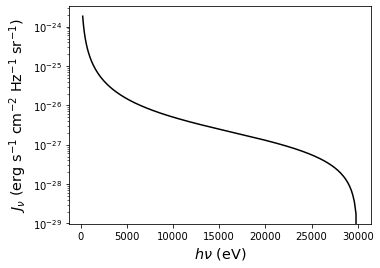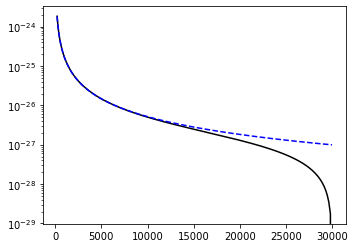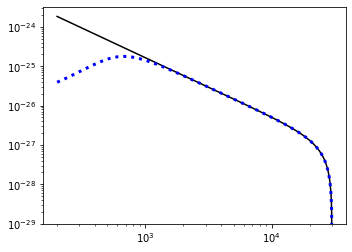The Metagalactic X-ray Background¶
In this example, we’ll compute the Meta-Galactic X-ray background over a series of redshifts (\(10 \leq z \leq 40\)). To start, the usual imports:
[1]:
%pylab inline
import ares
import numpy as np
import matplotlib.pyplot as pl
from ares.physics.Constants import c, ev_per_hz, erg_per_ev
Populating the interactive namespace from numpy and matplotlib
[2]:
# Initialize radiation background
pars = \
{
# Source properties
'pop_sfr_model': 'sfrd-func',
'pop_sfrd': lambda z: 0.1,
'pop_sed': 'pl',
'pop_alpha': -1.5,
'pop_Emin': 2e2,
'pop_Emax': 3e4,
'pop_EminNorm': 5e2,
'pop_EmaxNorm': 8e3,
'pop_rad_yield': 2.6e39,
'pop_rad_yield_units': 'erg/s/sfr',
# Solution method
'pop_solve_rte': True,
'tau_redshift_bins': 400,
'initial_redshift': 60.,
'final_redshift': 5.,
}
To summarize these inputs, we’ve got:
A constant SFRD of \(0.1 \ M_{\odot} \ \mathrm{yr}^{-1} \ \mathrm{cMpc}^{-3}\), given by the
pop_sfrdparameter.A power-law spectrum with index \(\alpha=-1.5\), given by
pop_sedandpop_alpha, extending from 0.2 keV to 30 keV.A yield of \(2.6 \times 10^{39} \ \mathrm{erg} \ \mathrm{s}^{-1} \ (M_{\odot} \ \mathrm{yr})^{-1}\) in the \(0.5 \leq h\nu / \mathrm{keV} \leq 8\) band, set by
pop_EminNorm,pop_EmaxNorm,pop_yield, andpop_yield_units. This is the \(L_X-\mathrm{SFR}\) relation found by Mineo et al. (2012).
See the complete listing of parameters relevant to :class:ares.populations.GalaxyPopulation objects here.
Now, to initialize a calculation and run it:
[3]:
mgb = ares.simulations.MetaGalacticBackground(**pars)
mgb.run()
We’ll pull out the evolution of the background just as we did in the UV background example:
[4]:
z, E, flux = mgb.get_history(flatten=True)
and plot up the result (at the final redshift):
[5]:
pl.semilogy(E, flux[0] * E * erg_per_ev, color='k')
pl.xlabel(ares.util.labels['E'])
pl.ylabel(ares.util.labels['flux_E'])
[5]:
Text(0, 0.5, '$J_{\\nu} \\ (\\mathrm{erg} \\ \\mathrm{s}^{-1} \\ \\mathrm{cm}^{-2} \\ \\mathrm{Hz}^{-1} \\ \\mathrm{sr}^{-1})$')

Compare to the analytic solution, given by Equation A1 in Mirocha (2014) (the cosmologically-limited solution to the radiative transfer equation)
\(J_{\nu}(z) = \frac{c}{4\pi} \frac{\epsilon_{\nu}(z)}{H(z)} \frac{(1 + z)^{9/2-(\alpha + \beta)}}{\alpha+\beta-3/2} \times \left[(1 + z_i)^{\alpha+\beta-3/2} - (1 + z)^{\alpha+\beta-3/2}\right]\)
with \(\alpha = -1.5\), \(\beta = 0\), \(z=5\), and \(z_i=60\),
[6]:
# Grab the GalaxyPopulation instance
pop = mgb.pops[0]
# Plot the numerical solution again
pl.semilogy(E, flux[0] * E * erg_per_ev, color='k')
# Compute cosmologically-limited solution
e_nu = np.array([pop.Emissivity(10., energy) for energy in E])
e_nu *= c / 4. / np.pi / pop.cosm.HubbleParameter(5.)
e_nu *= (1. + 5.)**6. / -3.
e_nu *= ((1. + 60.)**-3. - (1. + 5.)**-3.)
e_nu *= ev_per_hz
# Plot it
pl.semilogy(E, e_nu, color='b', ls='--')
[6]:
[<matplotlib.lines.Line2D at 0x18367a550>]

Neutral Absorption by the Diffuse IGM¶
The calculation above is basically identical to the optically-thin UV background calculations performed in the previous example, at least in the cases where we neglected any sawtooth effects. While there is no modification to the X-ray background due to resonant absorption in the Lyman series (of Hydrogen or Helium II), bound-free absorption by intergalactic hydrogen and helium atoms acts to harden the spectrum. By default, ARES will not include these effects.
To “turn on” bound-free absorption in the IGM, modify the dictionary of parameters you’ve got already:
[7]:
pars['tau_approx'] = 'neutral'
Now, initialize and run a new calculation:
[8]:
mgb2 = ares.simulations.MetaGalacticBackground(**pars)
mgb2.run()
# Loaded /Users/jordanmirocha/Dropbox/work/mods/ares/input/optical_depth/optical_depth_planck_TTTEEE_lowl_lowE_best_H_400x862_z_5-60_logE_2.3-4.5.hdf5.
and plot the result on the previous results:
[9]:
z2, E2, flux2 = mgb2.get_history(flatten=True)
[10]:
# Plot the numerical solution again
pl.semilogy(E, flux[0] * E * erg_per_ev, color='k')
pl.loglog(E2, flux2[0] * E2 * erg_per_ev, color='b', ls=':', lw=3)
[10]:
[<matplotlib.lines.Line2D at 0x183933350>]

The behavior at low photon energies (\(h\nu \lesssim 0.3 \ \mathrm{keV}\)) is an artifact that arises due to poor redshift resolution. This is a trade made for speed in solving the cosmological radiative transfer equation, discussed in detail in Section 3 of Mirocha (2014). For more accurate calculations, you must enhance the redshift sampling using the tau_redshift_bins parameter, e.g.,
[11]:
pars['tau_redshift_bins'] = 1000
The default optical depth lookup tables that ship with ARES use tau_redshift_bins=400, but tables with tau_redshift_bins=1000 are also provided. You can run $ARES/input/optical_depth/generate_optical_depth_tables.py if you’d like to generate tables with a different resolution.